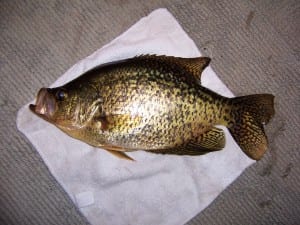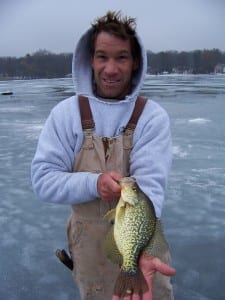| PFBC Cooperative Fish Habitat Management Programs for Lakes |
| What You Need to Know |
| The Pennsylvania Fish & Boat Commission’s Cooperative Lake Habitat Improvement Program has been in existence for over twenty years. With the foundation of the Division of Habitat Management, Lake Habitat Cooperators have more options than in the past. Currently two Commission programs exist solely for the purpose of working with individuals, organizations and other state and federal agencies to manage habitat improvement projects in commonwealth lakes and impoundments. The Cooperative Habitat Improvement Program (CHIP) and the Technical Assistance Program (TAP) are cooperative programs that are managed by staff within the Division of Habitat Management’s Lake Section that is part of the Commission’s Bureau of Fisheries, located in Bellefonte, PA.The Lake Section’s CHIP program is for long term fish habitat enhancement projects with cooperators that are able to partially fund projects with the Commission. The lake or impoundment to be improved must be state or federally owned or open to the public through an easement or management agreement. Trained Commission staff may provide technical assistance in design, in permitting, in artificial habitat construction and placement oversight. The trained Commission staff may also use specialized equipment and operators to construct artificial fish habitat structures. The Commission can provide matching material funding for Active CHIP Lake Projects. The Division of Habitat Management’s TAP program is aimed at short term projects that require only technical assistance. This technical assistance comes in the form of project design. Like the CHIP program, habitat managers will conduct habitat assessments and inventories of the individual lakes or impoundments and provide a CAD-drawn plan map showing depths and waypoint locations of specific artificial fish habitat structure proposed for the lake. The cooperator will receive this plan map and the associated plan narrative as a management plan for the waterway. Pennsylvania Fish & Boat Commission funding is not available to TAP cooperators, but lakes not open to the public may receive technical support through TAP. Both the CHIP program and the TAP program have been created to manage the design, the construction and the placement of artificial fish habitat in Pennsylvania lakes and impoundments. |
| Questions and answers about Lake Habitat Management in Pennsylvania Lakes |
| What is artificial fish habitat? Artificial habitat is fish structure designed to provide habitat features that allow fish (vertebrate and invertebrate animals) and reptiles to accomplish their daily and seasonal performance tasks with greater efficiency. Man-made habitat is considered artificial because it does not occur naturally. For the most part, the man-made habitat is used in man-made lakes (reservoirs & impoundments) which are artificial aquatic environments.Does the Commission have to get permits to place fish habitat in Lakes? The Commission’s Division of Habitat Management assists CHIP cooperators in their request to receive state and federal encroachment permits for fish habitat enhancement structure placement. TAP cooperators may use the Lake Section Designed Plan in a permit request to Pennsylvania’s Department of Environmental Protection. What does Fish Habitat Improvement accomplish? Artificial fish habitat may provide opportunities for angers to have greater success if the artificial habitat is accessible. But the main objective, is to increase the abundance of submerged native habitat materials, primarily, wood and rock rubble, through engineered structure design, that mimics native or natural habitat found in Pennsylvania impoundments. Wood and rock rubble are the key habitat elements that invertebrate and vertebrate animals use in lakes and impoundments. When the utilization aspect of fish habitat improvement increases the anglers’ success and provides opportunities for aquatic animals to increase in abundance and in efficiency, it is a win-win lake management tool. How expensive is Fish Habitat Improvement? Artificial fish habitat structure varies in cost due to the type, to the dimensions, to the materials used and to the regional values. An average cost of a typical, volunteer built, Pennsylvania style artificial habitat structure is $50.00. Add the cost of Commission staff time to design and to oversee project implantation, plus fuel and transportation costs, the estimated value of a typical submerged Pennsylvania style artificial habitat structure equals approximately $100. Considering that 90% of all Pennsylvania style artificial habitat structures constructed and placed in the last two decades are still submerged and functional, it is a pretty good value. How much does a typical Fish Habitat Improvement Project cost? Due to regional variations in material, transportation costs and inflation, project costs may vary. However, an average small scale fish habitat annual project may cost between $750 and $1,500. Normally, the Commission’s material costs are $500 to $1000 and the cooperator’s material costs are $250 to $500. The cooperator’s 50% cost match also includes, the value of the volunteer time. Typically speaking, between volunteer time and cooperator material and equipment continuations, the CHIP cooperator exceeds the 50% value of the project cost. Large-scale projects are far more expensive, averaging $10,000 to $50,000 depending upon the size and structure of the Large Scale Fish Habitat Project. What is the difference between large-scale and small-scale projects? Small Scale Lake Fish Habitat Projects have been part of habitat management for over 20 years and continue to be the mainstay of CHIP. Small scale projects normally have a 3 to 9 year life span, but a few have been ongoing for 20 years. Typically, a small scale project is conducted annually. Using adult and/or youth volunteer labor along with lake section staff and equipment, it is possible to construct and place 10 to 100 Pennsylvania style wooded artificial fish habitat structures in a single day. Large Scale Fish Habitat Projects are created by one of two basic elements in impoundments that have a dire need for habitat. One basic element is the impoundment in a condition where a large amount of habitat can be placed in a short period of time, such as a dam breach, a lake reclamation or a maintenance water drawdown. The other basic element is when funding becomes available, through a grant or a donation that provides the cooperator and the Commission an opportunity to accomplish a large-scale habitat project. Large scale projects may provide opportunities for volunteer involvement, but are typically accomplished using specialized aquatic and land-based equipment to construct and place hundreds of artificial habitats in a single day. Large scale projects may last a couple of weeks to a month. Who does the Commission work with to accomplish Lake Habitat Projects? The Commission’s CHIP program works with numerous organizations and agencies to cooperatively conduct small and large scale fish habitat projects. State agencies like, Pennsylvania’s Department of Conservation & Natural Resources’, Bureau of State Parks and the Pennsylvania Game Commission have been long time partners and cooperators. The U. S. Army Corps of Engineers, the U. S. Fish & Wildlife Service and the U. S. Forest Service continue to be valuable partners in the CHIP program. Numerous County Conservation Districts and County Park and recreation agencies have been long time cooperators, along with organizations like the Pennsylvania Bass Federation, the individual bass and fishing clubs, and the lake associations across the Commonwealth. This does not include the hundreds of youth and adult volunteers that work with cooperators annually, to provide the muscle to accomplish the 50 plus small scale projects that occur every year. Other state’s agencies are also involved in Pennsylvania’s cooperative fish habitat program. Ohio’s Department of Natural Resources’, Division of Wildlife, and Ohio State Parks both are involved in the annual habitat management project at Pymatuning Reservoir, since a portion of Pymatuning Reservoir is in Ohio. How do you determine if Artificial Habitat is beneficial? Scientifically speaking, determining the fishery population value of artificial fish habitat in a large impoundment may be close to impossible. An impoundment is an incredibly complex aquatic ecosystem and fish populations and natural habitat abundance vary greatly from day to day, season to season and year to year, due primarily to regional environmental conditions. The fish use of artificial habitat can be documented through various sampling methods. The night electro-fishing is the method most often used to sample habitat in depths of 5’ or less. Deep water habitat has been evaluated using submersible cameras and scuba diving. All of these are intrusive methods that can be used to study fish use of artificial habitat. A less intrusive method, but also less effective, is sonar sampling of habitat sites. Sonar can be used to determine if fish are relating to the artificial fish habitat structures, but sonar is not as effective to determine the abundance or the species richness as the other methods. Angling and angling satisfaction are another means to determine the value of a fish habitat improvement project. The Commission uses all of these methods in regimented studies, in passive sampling and in undocumented discussions with anglers and facilities managers. The Division of Habitat Management is increasing the amount of sampling and monitoring to try and learn more about fish and reptile use of artificial lake habitat structures. This comes at a good time, since in the near future we will be accomplishing more habitat projects than ever before. How many Lake Habitat Projects will the Commission be involved in by December 2009? It is estimated that the Lake Section will be involved with and conduct over 100 Small Scale Fish Habitat Projects and 6 Large Scale Fish Habitat Projects by 12/30/09. An estimated 3000 artificial habitat structures will be placed in Commonwealth lakes with the Commission spending an estimated $25,000. The cooperator and grant estimated contributions to total $125,000. Between grants, Pennsylvania Fish & Boat Commission project funding and cooperator contributions; the 4 person Lake Section is preparing to accomplish 100 lake habitat projects with an estimated materials cost of $150,000 in the next two years. This is an average cost of $50 per fish structure. This artificial habitat should last at least another two decades into the future. |
| Habitat Improvement |


 Fish Habitat Partnerships
Fish Habitat Partnerships




 Apache trout (George Andrejko, Arizona Game and Fish Department)
Apache trout (George Andrejko, Arizona Game and Fish Department)  Photo Credit: Greg Syverson
Photo Credit: Greg Syverson  Mexican Stoneroller
Mexican Stoneroller  `O`opu nopili
`O`opu nopili 

 protect, restore, and enhance priority habitat for fish and mussels in the watersheds of the Ohio River Basin. We pursue this mission for the benefit of the public, but what brings us to the table is as diverse as the basin itself. Whether it is sport fish, mussels, imperiled fish, water quality, or one of many other drivers, what bonds us is the Basin and our desire to work together to protect, restore, and enhance her aquatic resources.
protect, restore, and enhance priority habitat for fish and mussels in the watersheds of the Ohio River Basin. We pursue this mission for the benefit of the public, but what brings us to the table is as diverse as the basin itself. Whether it is sport fish, mussels, imperiled fish, water quality, or one of many other drivers, what bonds us is the Basin and our desire to work together to protect, restore, and enhance her aquatic resources. 


 restore listed anadromous salmonid species, and other
restore listed anadromous salmonid species, and other



